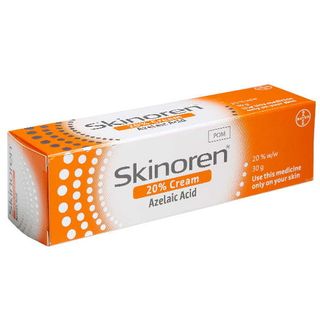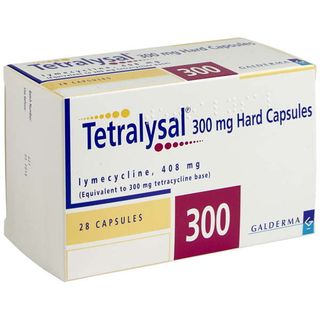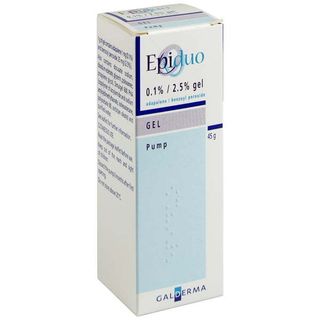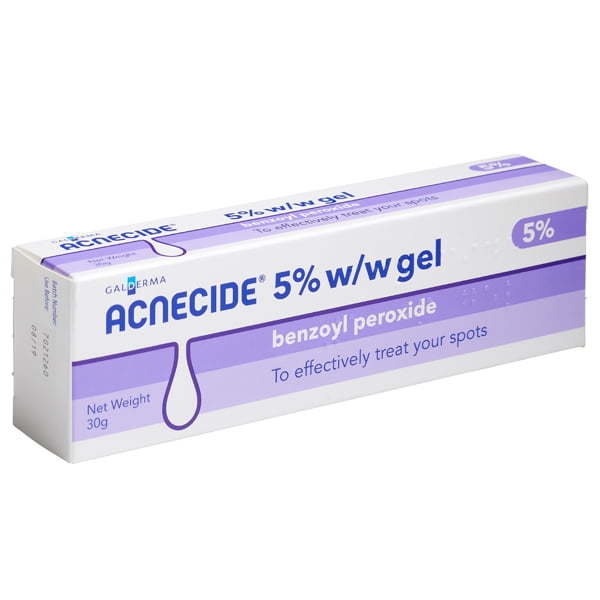
- Fast, discreet delivery
Delivered in secure, plain packaging on fully tracked delivery from just £2.95
- 100% UK-based pharmacy
Our team of doctors and pharmacists, and our support staff, are all UK-based.
- Free advice and support
Have a question? Telephone support is always free; Monday - Friday, 9am - 5pm.
- We're rated 4.9 out of 5
Based on over 24,000 reviews collected on Google and Reviews.io.
We maintain the highest possible regulation for a UK online pharmacy, ensuring your experience is safe, and confidential.
Acnecide 5% Benzoyl Peroxide Gel
Acnecide Gel contains 5% benzoyl peroxide and is, based on the reviews from the patients, an effective leave-on treatment for spots and acne affecting the face, chest, and back.
Start your journey to clearer, fresher-looking skin today. Buy Acnecide Gel online from The Independent Pharmacy by answering a few simple questions and get your benzoyl peroxide spot treatment delivered to you at home.
- Acnecide 5% Gel (30g)3
- Acnecide 5% Gel (60g)2
This treatment requires an online consultation for review by our medical team. The decision to supply the specific treatment and quantity requested will be based on whether our medical team are satisfied that it will be safe, appropriate, and effective.
- Type of medicine
- Antispetic
- Works by
- Killing bacteria on the skin responsible for acne
- Active ingredient
- Benzoyl Peroxide
- Effective within
- up to 4 weeks
- Pack size
- 30 and 60g
- Strength
- 5%
- Common side effects
- Dry skin, Redness, peeling and skin burning sensation
- Manufacturer
- Galderma (U.K) Ltd
- Generic
- No
- Use with alcohol
- No issue
Acnecide Gel Information
What Is Acnecide 5% w/w Gel Benzoyl Peroxide?
Acnecide Gel 60g and 30g contains the active ingredient benzoyl peroxide, a powerful antiseptic that kills up to 95% of bacteria on the skin that causes types of acne like spots, blackheads and whiteheads.
This product is applied directly to the affected skin, where it works quickly by not only killing bacteria but also absorbing excess oil.
Acnecide Benzoyl Peroxide Gel can be used by children and adults over the age of 12 years. For best results, it should be applied up to twice a day to all affected areas on the face, chest and back.
What Is Acnecide Gel Used for?
Acnecide 5% Gel is just one of many benzoyl peroxide treatments available to treat acne, spots, or pimples. When used alongside a gentle Acnecide Cleanser (now rebranded to Purifide Daily Cleanser) and Acnecide Daily Moisturiser, most people notice a visible improvement in the condition of their skin in just a few weeks.
- Topical antibiotics: Zineryt, Dalacin-T, Zindaclin
- Oral antibiotics: Tetralysal, Oxytetracycline
How Does Acnecide Gel Work?
Acnecide Gel contains the active substance benzoyl peroxide. It has antiseptic properties that mean it attacks the bacteria on your skin, which, when present, can lead to acne.
It also helps further reduce acne by unclogging the pores on your skin. It removes the dead skin that can build up and cause blockages. Helping to treat existing acne and, when used regularly, prevents further breakouts.
How Long Does Acnecide Gel Take to Work?
When used as directed, up to twice a day on all affected areas of skin, Acnecide Gel starts working straight away. Most people will see a noticeable difference in the appearance of their skin within 2 - 4 weeks.
For best results, it is recommended that Acnecide Gel is used alongside a gentle skin cleanser and a non-comedogenic moisturiser that does not block up the pores as part of your daily skin care routine.
If you do not see visible improvements to your skin within this time or you notice your skin condition getting worse, you should speak to a doctor or pharmacist for further advice.
How to Use Acnecide Gel
Acnecide Gel is suitable for use by children and adults over the age of 12 years for external use only.
- Wash the affected areas of the skin with a gentle skin cleanser and water.
- Pat the skin dry.
- Apply a thin layer of gel to all affected areas 1 - 2 times a day. If you have sensitive skin, apply once at bedtime.
Build up the Acnecide usage carefully and start with a once-a-day application in the evening for the first few days.
If you notice any drying or peeling of the skin, you should reduce the number of applications accordingly until your skin has settled and adjusted to this product.
Acnecide Gel Ingredients
Active Ingredients: Hydrous Benzoyl Peroxide
Inactive Ingredients: Docusate Sodium, Disodium Edetate, Poloxamer 182, Carbomer 940, Propylene Glycol, Acrylates Copolymer, Glycerol, Colloidal Anhydrous Silica, Sodium Hydroxide, and Purified Water.
Acnecide Gel Side Effects
Acnecide Gel may cause side effects in some people, but not everyone will experience them.
Most commonly, people report irritation at the sites of application, which may include:
- Dry Skin
- Redness
- Peeling
- Burning sensation
- Itching
- Pain or stinging
If you experience any of these side effects and you become concerned or they do not improve after you have stopped using Acnecide Gel, you should speak to a doctor or pharmacist for advice.
In very rare cases, some people may have a severe allergic reaction when using this product. If you experience any facial swelling, severe itching or burning or difficulty breathing, you should seek immediate medical help.
Please ensure you have read the Patient Information Leaflet thoroughly before using Acnecide Gel.
Acnecide Gel Warnings
- The product is for external use only. Avoid contact with eyes, mouth, nose and mucous membranes (for example, inside of your mouth or nose).
- Do not apply this product to damaged or broken skin.
- Make sure to avoid contact with hair, clothes or coloured fabrics, as Acnecide Gel contains ingredients that can bleach or stain. Wash your hands thoroughly after each application and, where possible, avoid contact with materials.
- As Acnecide can cause increased sensitivity to sunlight, avoid repeated or prolonged exposure to sunlight and other sources of UV light when using this product, either sunbeds or strong sunlight.
- Speak to a doctor or pharmacist before using Acnecide Gel if you are using any other treatment of acne on your skin or products that dry or peel, as this can cause the skin to become very sore.
- Keep in mind that excessive application will not increase the efficacy of the benzoyl peroxide product. Instead, it could increase the risk of skin irritation.
Please read the Patient Information Leaflet thoroughly before using this product.
Acnecide Gel & Pregnancy
You should not use this product if you are pregnant or breastfeeding before consulting a doctor. If you are advised to use Acnecide Gel while breastfeeding, you should not apply it to your chest.
Sources
- NHS (2022). About benzoyl peroxide - https://www.nhs.uk/medicines/benzoyl-peroxide/about-benzoyl-peroxide/
- Acnecide Gel Patient Information Leaflet:https://www.medicines.org.uk/emc/product/2225/pil
Acnecide Gel reviews
Acnecide Gel FAQs
It can take up to 6-8 weeks in order to see any tangible results, so keep applying the gel as directed and persist with the treatment. If you find that you still do not get the results you want from Acnecide, you may wish to try a combination product such as Duac or Treclin, which contain a topical antibiotic and a keratolytic for a dual mechanism of action.
You probably need to take it for about two months to get the full benefits of the treatment.
You can use Acnecide for as long as you need to keep your skin clear of acne. If you are using it continuously, we normally recommend a break from treatment every six months to reassess your acne and give your skin a break from treatment. If your acne starts to come back, you can start using Acnecide again.
Anyone allergic to benzoyl peroxide or any of the other ingredients should not use Acnecide gel. We would not recommend the use of benzoyl peroxide whilst pregnant or breastfeeding as the safety of the medicine during these times has not been fully established.
Like all medications, Acnecide has some common and less common Acnecide side effects. Some people may experience a mild skin irritation or adverse reaction to the gel. Any mild irritation and redness caused by Acnecide at the start of treatment will usually subside within a few weeks.
It can cause skin dryness in some people and, more rarely, contact dermatitis. It also makes your skin more sensitive to sunlight, so you need to take extra precautions when using the gel.
Using Acnecide at the same time as some other acne treatments can lead to excessive dryness and skin irritation, so always check with your pharmacist before buying. Isotretinoin (also known as Roaccutane) can react with Acnecide and dry out your skin, so it’s best to avoid mixing these two treatments.
Acnecide is best used to complement topical or oral antibiotic treatment in moderate to severe acne. When used in this way, it has been shown to have better results than either treatment used alone.
Acnecide should not be used with other drying or keratolytic treatments such as Duac, Differin, Epiduo, or Treclin.
Mainly other acne treatments like Acnecide wash, Duac gel, Quinoderm gel and Epiduo gel.
There are many different ways to reduce acne scarring, and it’s best to speak to a dermatologist about the most appropriate treatment. Acnecide can reduce scarring, as can salicylic acid.
It won’t address the underlying hormonal changes that are causing your acne, but it will treat the spots and pustules on your skin. You may also want to seek hormonal treatment like the contraceptive pill from your GP or dermatologist.
It won’t make your spots worse, but like all acne treatment gels, it can cause some irritation and sensitivity. This is most likely to occur in the first few weeks of treatment and usually subsides after this.
You can buy Acnecide 30g at a pharmacy without a prescription, but you will need to speak to a pharmacist first. This is to ensure that the treatment is right for you. Acnecide 60g gel is a prescription-only treatment that you can get from your GP or buy online from The Independent Pharmacy from our Online Doctor.
It shouldn’t, but if you have an adverse reaction — stop using it immediately.
In order to get the best results, you should wash your skin with a mild cleanser before applying the gel. Then, apply Acnecide to your skin, and once it has been absorbed, you can apply a non-perfumed moisturiser if necessary.
They both break down the skin’s keratin (known as keratolytics), but benzoyl peroxide is more effective as it’s also antibacterial. It’s a more effective acne treatment than salicylic acid because it’s more comprehensive and addresses more causes of acne.
Yes, it works on all forms of acne and spots. Salicylic acid is often found in blackhead washes and scrubs you can buy on the high street, but benzoyl peroxide is a more effective all-around acne gel.
When it comes to choosing between an acne gel and a cream, there is not much difference. Often, it has to do with the drug’s pharmaceutical formation rather than anything else. A gel is water-based so can be drying and also can leave a thin film on the skin. Creams are more oily than gel and are better if the skin is dry. Generally, it is the active ingredient in acne treatments that determines how effective an acne treatment is rather than the formulation (cream, gel, etc).
Acnecide is exactly the same as Quinoderm — it’s just got a different brand name as it’s being sold by a different company. Quinoderm used to be made by BP and has now been discontinued, so if you liked it — you should switch to Acnecide.
Related Treatments
- Best seller
 Skinoren 20% Cream£15.49140 reviews
Skinoren 20% Cream£15.49140 reviews - Out Of Stock

Tetralysal Capsules
Tetralysal (Lymecycline) 300mg Capsules£17.49225 reviews 
Epiduo
Epiduo & Epiduo Forte Gel£33.0020 reviews
Visit our Acnecide Gel page for treatments, advice and FAQs.
Ordering as easy as 1, 2, 3
1. Find the ideal treatment
We can provide over 1099 leading medicines to treat over 94 conditions.
2. Get a free consultation
Our qualified healthcare professionals will assess your condition and needs.
3. Enjoy speedy delivery
And when the time comes to re-order, it'll only take a couple of clicks.
